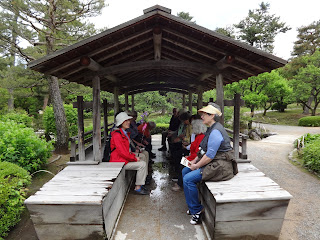Thursday, May 12
After breakfast in our hotel, we began to explore Kanazawa with a guided tour of the city.
Between the 16th and 18th centuries, Kanazawa was a prosperous castle town in the domain of Kaga, ruled by the Maeda Family, and it has been one of the cultural centers of Japan ever since. Located on the coast of the Japan Sea, Kanazawa was spared much of the destruction that WWII brought to the country.
Kenrokuen Garden and Circumference of Kanazawa Castle Park
We started our tour with a morning visit to Kenrokuen Garden, one of the most beautiful in Japan.
The garden is located outside the gates of Kanazawa Castle where it originally formed the outer garden, and covers over 25 acres. It began in 1676 when the 5th lord Maeda Tsunanori
moved his administration to the castle and began to landscape a garden
in this vicinity. This garden was, however, destroyed by fire in 1759.
The garden restoration was begun in 1774 by the 11th lord Harunaga, who created the Emerald Waterfall (Midori-taki) and Yugao-tei, a teahouse. Improvements continued in 1822 when the 12th lord Narinaga created the garden's winding streams with water drawn from the Tatsumi Waterway. The 13th lord Nariyasu
subsequently added more streams and expanded the Kasumi Pond. With
this, the garden's current form was complete. The garden was opened to
the public on May 7, 1874.
The Maeda family resided in Kanazawa Castle and
governed the Kaga Clan (the present Ishikawa and Toyama areas) for
more than 280 years henceforth. The castle tower was burned down by
a fire in the past and has not been rebuilt, but other fortress buildings
were reconstructed repeatedly. The Ishikawamon Gate, which was rebuilt
in 1788, and the Sanjikken Nagaya (50-yard-long warehouse), which
was rebuilt in 1858, still remain.
After the garden, we visited one of the many houses of Kanazawa where the samurai -- Japan's famed class of noble warriors -- once lived. Several former samurai homes still stand on winding streets and many are still in use as residences. We enjoyed a closer look at what constitutes samurai style when we explored the 18th century Terashima House, home of a samurai who was also a painter.
Kurando Terashima was a middle-class samurai of the Maeda
family. It is said that this house was constructed in the latter
half of the 18th century. The existing mansion, storehouse, and
mud wall tell the actual condition of the middle-class samurai residence.
Dodan tsutsuji (a kind of azalea), which blooms from the end of
April until early in May and the autumn leaves are the highlights
of the garden. Kurando was a painter as well, and his works are
exhibited in the house.
Lunch was at a local restaurant and consisted of salad, salmon and green tea mousse.
Our next stop was the Gold Leaf Museum where we first watched a film on hammering gold leaf, which
explained the process of
gold-leaf making. Thin sheets of gold have been produced in Kanazawa since the 16th century. There were also visual displays
which were translated into English.
From there we proceded to the Geisha district where several of the shops featured products covered in golf leaf (gilt). The gold leaf is used to decorate everything from handcrafts to Buddhist alters. There were ice cream shops that used pieces of edible gold leaf in their ice cream, although I didn't try it.
On the same street, we visited Kaikaro, a 190 year old teahouse where geishas perform. The geishas perform in the evening (admittance by referral only), but the teahouse is open to visitors during the day. The decor was a true fusion of modern and ancient Japan. A young women in a kimono explained to us the role and duties of the Geishas in their teahouse. The previous evening two women from the United States had been entertained by Geishas in this teahouse at a cost of about $1600. The Geishas play instruments, sing and dance. The guests are also served a sumptious meal.
On the bus ride back to the hotel, Mary, Beth, Nancy and I requested to get off at the Omicho Market. Even though it was closed on Thursdays, we walked through just to get an idea of what they had. It smelled very fishy!
Mary had determined that we could get quilt fabric in the department store so we went across the street to the store that purportedly had such fabric (even tho' Akiko didn't think they would have it) and found the fabric and crafts department. A young lady working in the department pointed out the Japanese fabric (most of the fabric was from the US) and I found three fabrics that I liked and bought 5 meters totally. The price was 930 yen per meter (under $9 per yard) for fabric that would run about $12 per yard in the U.S. so I felt that, at least, I hadn't paid a premium to buy it in Japan.
Mary and I later walked through the Kanazawa station looking for a place to find pot stickers. The station is like a shopping mall with shops where you can buy almost everything you can think of. Not locating the place Akiko had mentioned for pot stickers, we bought pastries at a German bakery and took them back to eat in our respective rooms for dinner.
Kanazawa station:
There is a glass
dome called "Motenashi (Welcome) Dome," which looks like
a huge umbrella, at the east entrance of Kanazawa Station. The dome
has a wooden gate called "Tsuzumi-mon," which symbolizes
a traditional Japanese instrument called tsuzumi (hand drums).





































































